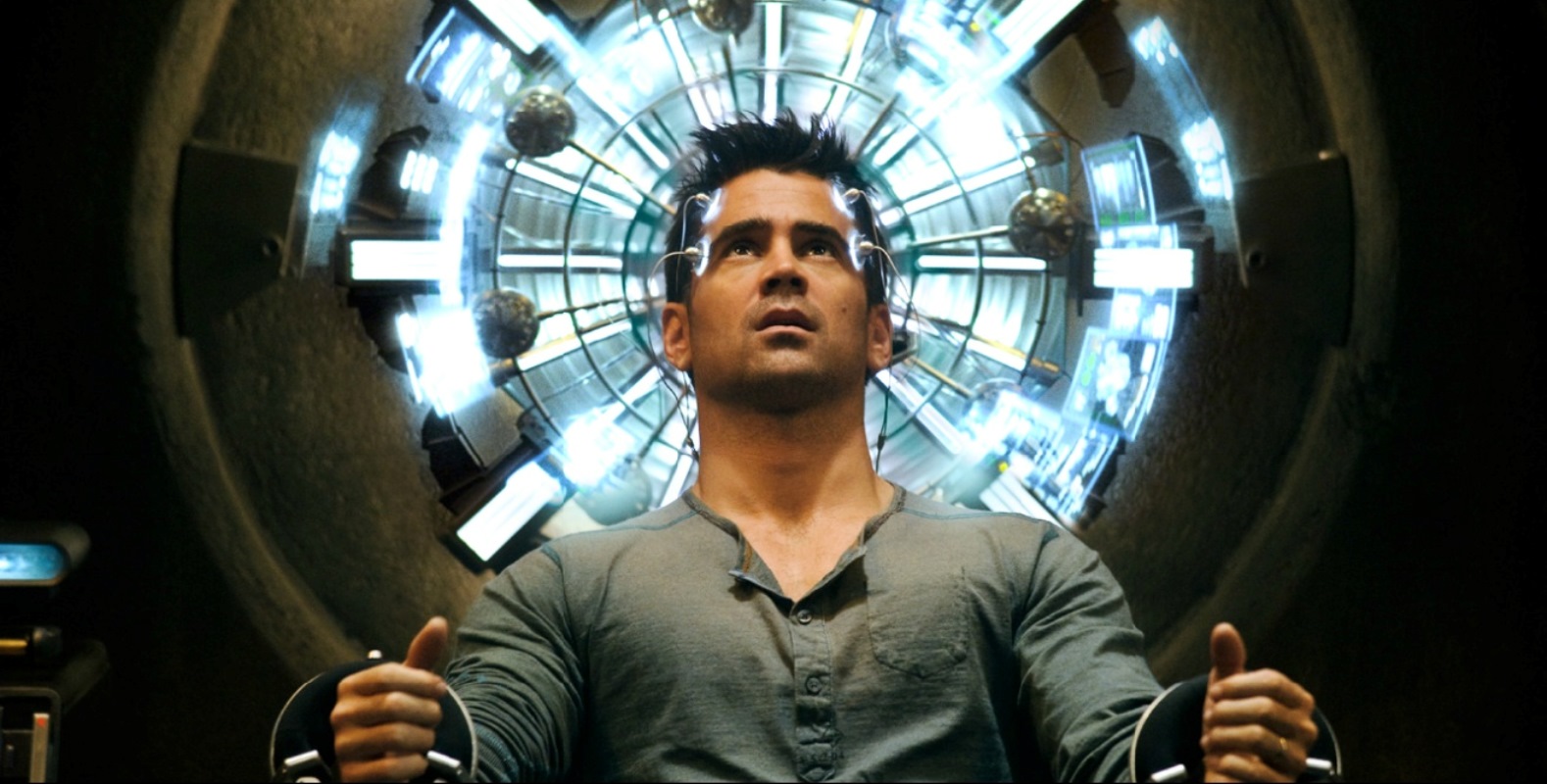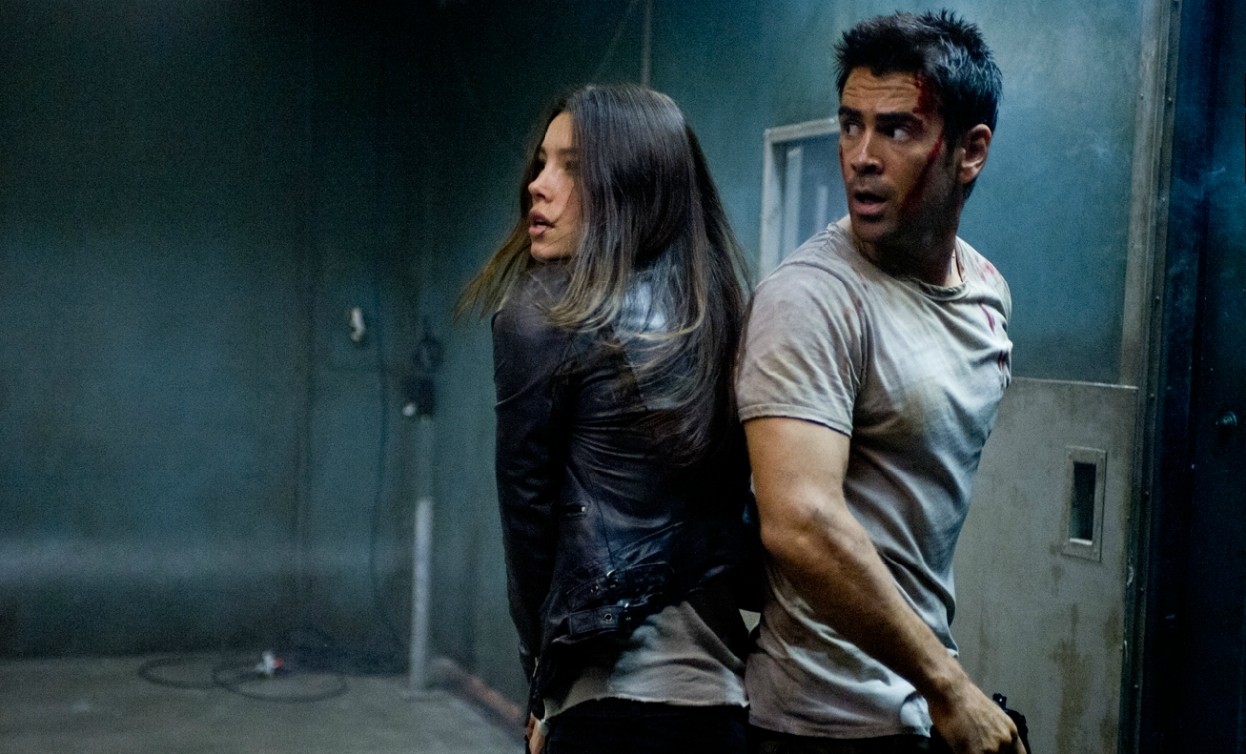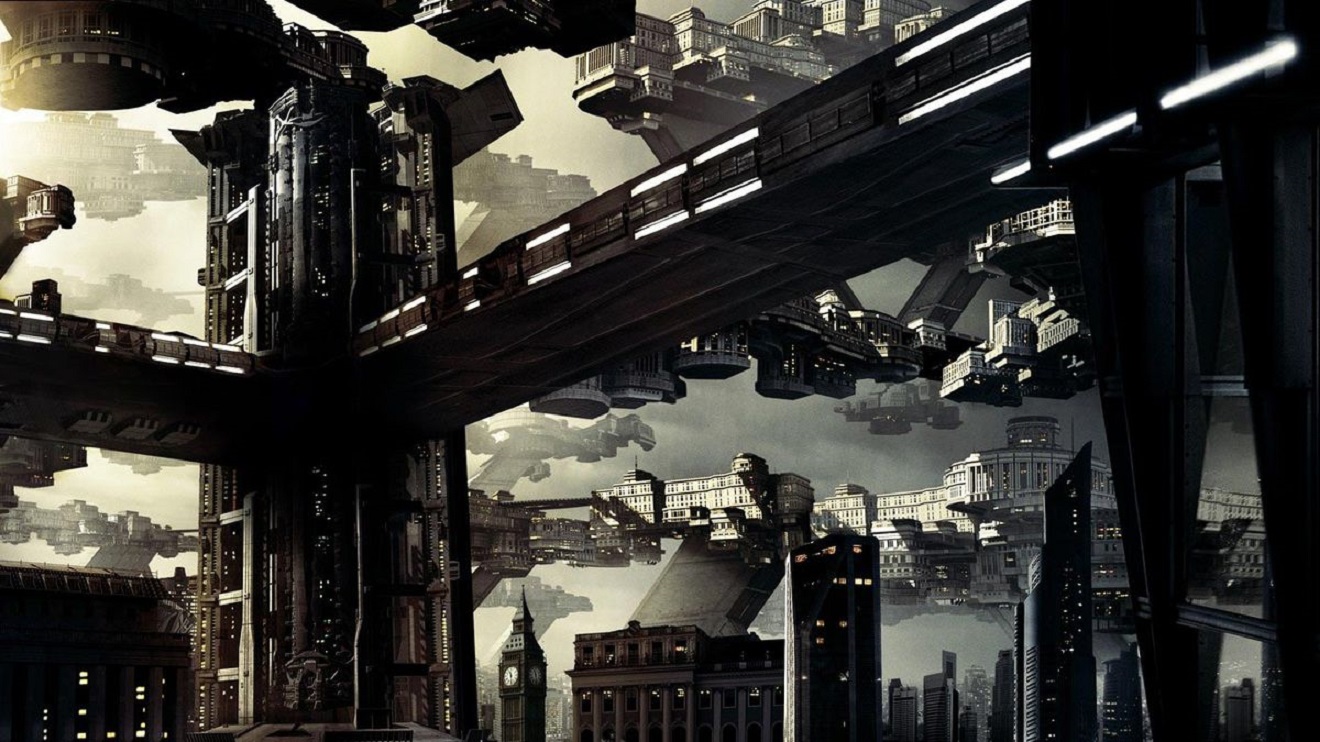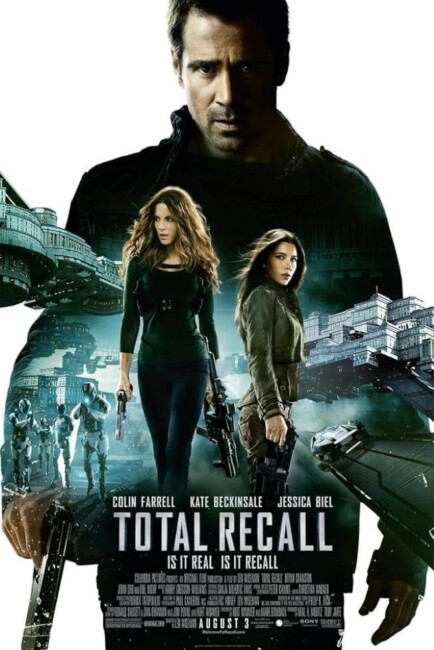Crew
Director – Len Wiseman, Screenplay – Mark Bomback & Kurt Wimmer, Screen Story – Dan O’Bannon, Jon Povill, Ronald Shusett & Kurt Wimmer, Based on the Short Story We Can Remember It For You Wholesale (1966) by Philip K. Dick, Producers – Toby Jaffe & Neal H. Moritz, Photography – Paul Cameron, Music – Harry Gregson-Williams, Visual Effects Supervisor – Peter Chiang & Adrian De Wet, Visual Effects – Baseblack, Buf, Double Negative (Supervisor – Nathan McGuinness), Lipsync Post (Supervisor – Sean H. Farrow), MPC (Supervisor – Charles Henley) & Prime Focus, Special Effects Supervisors – Laird McMurray & Clay Pinney, Makeup Effects – Legacy Effects, Production Design – Patrick Tatopoulos. Production Company – Original Film.
Cast
Colin Farrell (Doug Quaid/Karl Hauser), Kate Beckinsale (Lori Quaid), Jessica Biel (Melina), Bryan Cranston (Councillor Cohaagen), Bokeem Woodbine (Harry), Bill Nighy (Mathias), John Cho (McClane), Dylan Scott Smith (Hammond)
Plot
In the 21st Century, vast areas of the Earth have been rendered uninhabitable. The two zones that remain are the United Federation of Britain and The Colony, the former Australia. The two are connected by The Fall, a high-speed train that runs through the centre of the Earth. Doug Quaid works a dead end job on an assembly line building robots for the Federation security forces. He decides to go to Rekall Inc, a company that offers to implant artificial memories and chooses a spy adventure scenario. However, something goes wrong as the memories are injected and security forces burst in and start shooting. Somehow the Rekall implant has activated buried memories of Quaid’s true identity as a spy. Quaid’s wife Lori reveals that she is a security forces plant and starts hunting him. Fleeing, Quaid falls in with the resistance fighting against United Federation’s autocrat Cohaagen and finds that his buried personality has vital information that is sought by both sides. On the other hand, those pursuing him insist that all of this is part of the illusion from the Rekall memory implants that have gone wrong.
Total Recall (1990) was one of Arnold Schwarzenegger’s biggest hits, although it is not a film I particularly like. The large problem with it was a mismatch between script and the approach of its director and star. It comes from a short story We Can Remember It For You Wholesale (1966) by Philip K. Dick. Total Recall was only the second film adapted from the works of Philip K. Dick who has since become a regular source in genre cinema (see below for other Dick adapted work). Dick’s science-fiction specialises in questions about the nature of reality where the typical Dick protagonist regularly discovers that the world around him is a construct or that he is an android without realising it.
The problem with Total Recall was that Dick’s story, a witty piece about a man caught up in a labyrinth of artificial memories, ended up as a vehicle for Arnold Schwarzenegger and placed in the hands of action director Paul Verhoeven, known for works like Robocop (1987), Basic Instinct (1992), Showgirls (1995) and Starship Troopers (1997) that place emphasis on a numbing excess of sex and violence. The original director assigned to Total Recall had been David Cronenberg and one suspects his sensibilities would have been far better suited to Dick’s mind-bendings than Paul Verhoeven’s ended up being.
Here Total Recall is inevitably remade, as almost every successful work from that era has been. The remake has been placed in the hands of Len Wiseman, who previously made Underworld (2003), which spawned the successful franchise, and directed its sequel Underworld: Evolution (2006), followed by Live Free or Die Hard (2007). Underworld, which also starred Kate Beckinsale who became Mrs Wiseman shortly after, was a film of slick poses. Alas, Underworld: Evolution and Live Free or Die Hard revealed Len Wiseman as a director who has become infatuated with overblown special effects, frequently at the expense of story or credibility. The choice of Wiseman as director did not exactly spell much promise for Total Recall – you can see from his resume that his focus is on action and special effects, which is precisely what wrecked Total Recall 1990.

The script for the remake has been placed in the hands of Kurt Wimmer, the writer of Sphere (1998), The Thomas Crown Affair (1999), Law Abiding Citizen (2009), Salt (2010), Spell (2020) and the remake of Point Break (2015), as well as director of Equilibrium (2002), Ultraviolet (2006) and Children of the Corn (2020) and Mark Bomback, who has written works like Godsend (2004), Live Free or Die Hard, Race to Witch Mountain (2009), Unstoppable (2010), The Wolverine (2013), Dawn of the Planet of the Apes (2014) and War of the Planet of the Apes (2017).
It is not often that a remake that gets the opportunity to work over a bad film – almost all remakes are logically of original films that were well-liked and successful. In this regard, Total Recall 1990 gives ample room for any remake to improve. Mark Bomback and Kurt Wimmer conduct a number of changes. The most substantial of these is that they have eliminated Mars as a location. In its place, they set everything on Earth and create a scenario where the world is divided into two locations – the United Federation of Britain and The Colony, which comprises Australia. There is also now much action set around a high-speed tube train that travels the tunnel that separates the two. I don’t think these are changes that particularly improve or detract from the story in any way.
The remake gets in a certain amount of fanservice – there is an appearance from the three-breasted hooker, while Colin Farrell is briefly offered a Mars adventure as one of the scenarios when he goes to Rekall. On the other hand, the remake does miscue some of the classic scenes from the original. The scene where Arnold Schwarzenegger passes through customs in disguise as a big-bodied lady, only to be sprung is replayed here with a different disguise and far less effect (the disguises are now holographic and employed regularly throughout). Some of the cuter, well-remembered touches from the original such as the Johnny Cabs and the secretary who sits electronically changing the colour of her fingernails are missing.
The other complaint might be that the remake never creates something as epical to go out on as the scientifically preposterous scene where Arnold Schwarzenegger manages to terraform Mars’s atmosphere in about five minutes flat. There are some scenes with Colin Farrell and Bryan Cranston fighting and a number of things blown up, signalling the saving of the world and freedom from oppression – but the original still held something more epical, even if this version is operating with two decades of improvement in terms of special effects.

The problem that Total Recall 2012 suffers from is that Philip K. Dick-esque reality bendings were clever in 1990 but have become far more commonplace by 2012. Total Recall 1990 came out before the spate of reality labyrinth films that emerged along with the idea of Virtual Reality. In the two decades interim, we have watched a host of films about protagonists caught up in Dick-ian questions of what is real, of whether their identities, memories and perception of the world are constructs with the likes of Open Your Eyes (1997), Dark City (1998), The Truman Show (1998), The Matrix (1999), Cypher (2002), Eternal Sunshine of the Spotless Mind (2004), The Forgotten (2004) and Inception (2010) to name but a handful – not to mention the spate of films that emerged influenced by M. Night Shyamalan and his preponderance for left-field reality bending endings. The problem is that Total Recall 2012, in reasonably closely following the plot of the 1990 film, ends up now seeming a work that follows in the footsteps of these others and does nothing particularly original with its ideas. Kurt Wimmer, Mark Bomback and Len Wiseman never do much with the questions of perception and reality, apart from one scene where Bokeem Woodbine comes in to confront Colin Farrell, and fail to turn the film on its head in a Dick-ian way and make us doubt everything that has happened.
On the other hand, I ended up liking Total Recall 2012 far more than I did the original. Len Wiseman surpasses himself. I expected he would do no more than turn the film into another bludgeoning ultra-violent action fest like Paul Verhoeven or one that was driven by ridiculously over-the-top action sequences as in Live Free or Die Hard. Contrarily, Wiseman succeeds in grounding all of the action scenes within the narrative, none of which are absurd and over-the-top. Some of them are particularly imaginative staged – notably a sequence with Colin Farrell and Jessica Biel in a hovercar pursuit from the authorities, or one with they engaged in shootouts with the security robots while in a train as it hits a zero gravity spot and some of the shootouts around the maze of elevators. All of these are credible and exciting action sequences where Wiseman shows a commendable restraint and places focus on imagination and tension that shows a newfound maturity as a director.

One of the best things about Total Recall 2012 is the design of the future. Where the 1990 version lacked anything distinctive in this regard, the designers here have gone back and studied Blade Runner (1982), the first adaptation of any of Philip K. Dick’s works to the screen. Out of this, they have located the film inside a credible Cyberpunk world – one heavily drawn from the Blade Runner look of crowded warrens of streets thronging with life, rundown buildings, neon signs, perpetual rain and a predominant Chinese influence on the culture. Particularly imaginative are some of the throwaway pieces of background technology – cellphones that have been inserted in the palm of the hand and display visuals when pressed against glass surfaces, fridges with digital displays for pictures and notes (something that you can lay bets on some designer launching in the marketplace any day soon), illuminated tattoos, the casual use of holography throughout, electronic lassos and weapons that fire miniature cameras into a room that can be observed via a holographic display and control panel in a robot’s backpack. It is an amazingly well designed world from top to bottom. Added to some expectedly top-drawer special effects that create a world that exists on multi-tiered levels with hovercars, elevators and entire buildings that vertically and horizontally move between these, the look of the film is amazing.
I also applaud the casting of Colin Farrell over Arnold Schwarzenegger. Farrell makes for a convincing everyman, not the superhuman bodybuilder that Schwarzenegger did – you can at least convincingly believe Farrell is working a nowhere job on a construction line where Schwarzenegger tips it off that he is a plant from the outset. Kate Beckinsale takes up a rare villainous role in the part played by Sharon Stone in the original and goes for broke with a real kick-ass lethality where you wonder if she is not working out some personal issues of marital strife in the process.
On the other hand, Jessica Biel is entirely forgettable as she has been in everything else one has seen her – she was the same in her one other Philip K. Dick adaptation Next (2007). Bryan Cranston, the constant wonder from tv’s great Breaking Bad (2008-13), is cast in an entirely generic villain role and gets little opportunity to do much – not to mention has a plan to build an army of robots that look like stormtroopers and a similarly convoluted scheme that makes him seem like a copy of Ian McDiarmid’s Emperor from Star Wars Episode II: Attack of the Clones (2002) and Star Wars Episode III: Revenge of the Sith (2005).
Other films adapted from the works of Philip K. Dick are:– Blade Runner (1982), Screamers (1995), Impostor (2002), Minority Report (2002), Paycheck (2003), A Scanner Darkly (2006), Next (2007), The Adjustment Bureau (2011), Radio Free Albemuth (2014), the tv series adaptation of The Man in the High Castle (2015-9) and the tv anthology series Philip K. Dick’s Electric Dreams (2017-8). The Gospel According to Philip K. Dick (2000) is a fascinating documentary about Dick’s bizarre life.
(Winner for Best Production Design, Nominee for Best Special Effects at this site’s Best of 2012 Awards).


